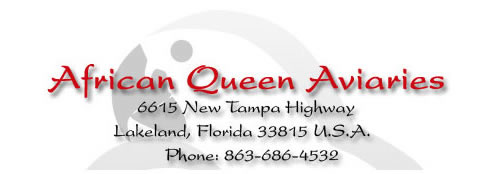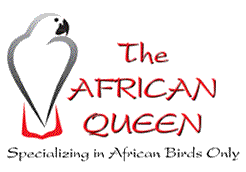Senegal Parrot Overview - Breeding to Pet
Jean Pattison
The Senegal, Poicephalus senegalus, belongs to a small group of parrots from Africa known as Poicephalus. Phonetically it is pronounced poy-seff-ah-luss, which means variably colored head.
Prior to the enactment of the Wild Bird Conservation Act of 1992, thousands of Senegal parrots were imported into the U.S. for the pet trade. Unfortunately none of the wild caught birds in the Poicephalus family tamed down well enough to be a good companion pets so they were labeled as flighty and biters. Thankfully many of the smaller birds, such as the Senegal, were purchased by aviculturists, set up for breeding and produced well in captivity. A big factor in raising these nine-inch parrots was their ability to become comfortable with their own kind in captivity. The temperament of the captive-raised Senegals doesn't compare to their wild-caught relatives. Hand-fed Senegal parrots make wonderful companion pets as they are inquisitive, learn to perform ticks readily and pick up mimicking words and sounds quickly.
Chicks raised years ago from newly imported birds were flighty and unpredictable, due to the nervous nature of the parents while in the nest. Many aviculturists from the late 70s and early 80s were disappointed with the temperament of the chicks and often took chicks from the parents before their eyes opened, or incubated the eggs, or finally sold their pairs. With determination, many aviculturists held on to their breeding stock and learned that Senegals did much better when they were allowed to choose their own mates. These birds, with time, settled in and became very secure in their environment producing chicks on a regular basis. Senegal parrots are outstanding parents, taking excellent care of their chicks. A clutch of babies from a pair ten years ago would be unrecognizable as a clutch from the same pair today, due to the different temperaments.
One is lucky to find a Senegal chick anywhere near Christmas time due to their seasonal breeding. Senegals usually start laying eggs in November and go through May, laying two clutches. Where breeders are located indoors, there may be a few pair who lay at odd times of the year.
When hand-feeding Senegal chicks there are a few things worth noting regarding their behavior. Senegal chicks are not strong beggars if they are fed well and are satisfied. Consequently it is very easy for a Senegal to lose its feeding response and become quite passive about being fed. This can be quite frustrating to the hand-feeder if there are a number of babies in the nursery. To avoid or overcome this problem one can allow the chicks to go a bit longer between a few feedings, and insure the temperature of the food is quite warm when feeding. Many aviculturists, myself included, feed with the formula temperature at 110 degrees. A word of caution, be sure to thoroughly mix the formula to rid it of hot spots, and test it with a thermometer. If you do not have a thermometer then taste test the food yourself to insure it is not too hot. It seems African species like their foods hot, and the nursery temperature slightly cooler than most other species.
Senegals often regurgitate some of their formula. If the amount is small, do not be alarmed. If during a feeding session, small amounts are fed while stopping to play or while refilling the syringe, then the bird may regurgitate during the whole feeding process. This, of course, should be avoided. It is often better to feed them their formula as quickly as possible to keep this behavior from becoming a habit. A bit of the formula brought up at the end of the feeding session is normal for some. If the problem persists or is objectionable, one may switch brands of formula, and the problem often ceases.
After pulling the chicks from the nest for hand feeding, one may notice a very alarming red stain ring around the chicks' droppings. This may happen for several days and then stops. Many aviculturists have had their veterinarian run tests to find what causes this red staining among the droppings and to date there has been no reported cause.
The stages of behavioral development in babies can be quite marked. A Senegal usually goes through oblivion, fearfulness, curiosity, aggression, friendliness, and just prior to weaning, apprehension and curiosity once again. Once the chicks are weaned they become very confident and social. Senegals may have a sibling aggression problem and if one is not aware of this, it can be over looked entirely. At certain times of development a chick may become shyer or a bit more reserved, even to the extreme behavior of flipping over on it's back with fear. This can be from the clutch-mates picking on an individual chick. Separating a chick, that seems just a little off from the others, for a few days will almost always turn the behavior around.
If wing clipping can be avoided until after the chick is weaned, the chick weans easier. It also helps prevent insecurity in a juvenile Senegal. Of course, in a shop situation this may be impossible with people in and out of doors all day. When clipping any of the African parrots it should be noted they are very heavy bodied and "drop like a rock" when rendered flightless. I recommend only removing the first five primary feathers from the outer tip of the wing inward. As the chick becomes stronger one or two more feathers may be removed. This wing clip is not advisable for the customer who takes their bird out side while not in a cage or carrier.
As pets the Senegal can be a real heart stealer. They adore their caretaker, and they expect the same adoration in return. You need never worry about getting a "friend or companion" for your Senegal. They prefer their owner above any other, and can sometimes be quite resentful of the buddy. A second bird in a Senegal household should always be purchased for the caretaker, not the resident Senegal. If the Senegal is a first bird, and another bird is acquired later on, a wise practice is to always play and interact with the Senegal first. This eliminates the Senegal's notion of alienated affection.
When a Senegal is demonstrating a bad behavior, such as chewing a button off of a shirt, rather than responding with a negative action a favorite chew toy should be offered. Bad behaviors are much more readily corrected by changing the subject, than by negative reinforcement. African parrots take any negative reaction to heart, and can hold a grudge forever.
Senegals need daily interaction with their owners to keep them from becoming cage bound. They can easily become devoted to just one person. It is important to have every member of the family interact with the Senegal to discourage this type of behavior if one is looking for a family bird.
Where caging is concerned, it is often said that bigger is better. This is not always the case with the Senegal. The Senegals wild ancestors are nervous birds by nature and the security of a smaller cage is sometimes better for their domestic offspring. A cage measuring 24″ high, 18″ wide and 18″ deep will adequately house a Senegal. If a caretaker fills a cage to the brim with toys and swings (a Senegal's favorite), then obviously a larger cage is warranted. A variety of toys are essential in keep this energetic little parrot entertained, and changing them often helps to keep their interest.
It is wise to teach a Senegal to use a water bottle as well as a bowl. It is advisable to use both so clean water is available at all times. Domestic Poicephalus seem to have a propensity to dunking their pellets and making soup. Senegals love to bathe and this activity should be encouraged by providing a shallow bowl of water. When using a water bottle be careful the Senegal doesn't learn how to stuff food up the tube to get it wet. There have been occasional deaths due to the bottle being stopped up because of this practice especially when this was the only source of water.
Feeding a Senegal is relatively easy. They do not have any major dietary problems. Base diets of pellets are preferred. The best pellet caretakers can feed is the one their Senegal will eat, and one that is readily available in their area. Along with pellets a few seeds as treats are recommended, along with a bit of table food high in beta-carotene (the precursor to vitamin A). These foods consist of dark yellow vegetables such as sweet potato and carrots, and dark green leafy vegetables.
Senegals are wonderful birds for apartment dwellers due to their size and quiet behavior. They can learn to say a few phrases, which they take delight in repeating to their owners. Some have been known to have huge vocabularies.


